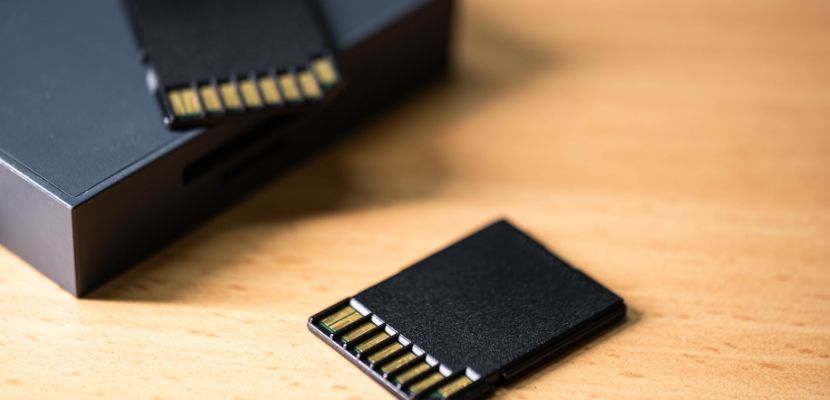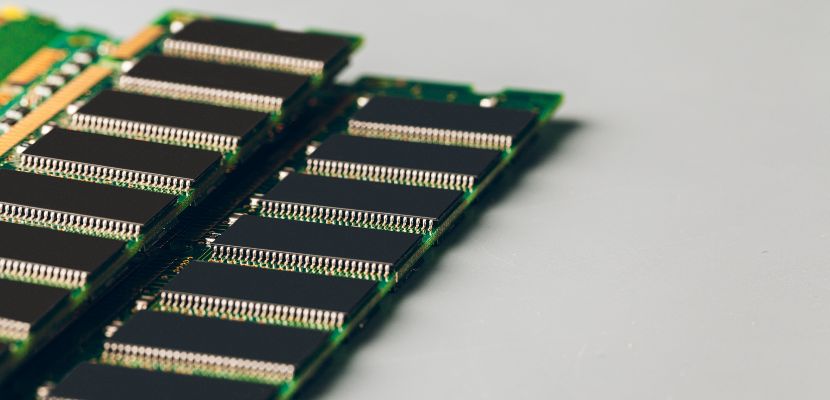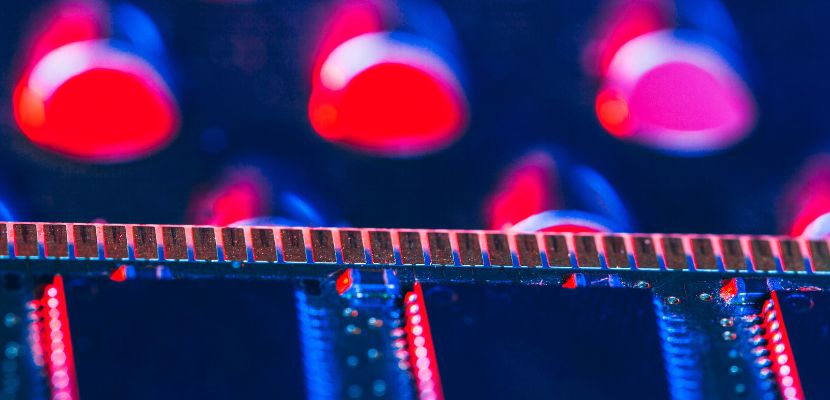A dual inline memory module (DIMM) is a type of computer memory module that provides high-speed, temporary data storage for systems to process information efficiently.

What Is a Dual Inline Memory Module (DIMM)?
A dual inline memory module is a circuit board that houses a series of dynamic random-access memory (DRAM) chips, designed to provide temporary, high-speed data storage directly accessible by a computer’s processor.
Unlike earlier single inline memory modules (SIMMs), DIMMs feature separate electrical contacts on each side of the board, effectively doubling the data path and enabling faster and more efficient communication with the system.
DIMMs are manufactured in various capacities, speeds, and form factors, with specifications such as DDR, DDR2, DDR3, DDR4, and DDR5 defining their performance characteristics and compatibility with different generations of motherboards. They are inserted into dedicated slots on the system’s mainboard and work in conjunction with the memory controller to temporarily hold data and instructions needed by the CPU, reducing the need for slower access to long-term storage.
By serving as a fast intermediary between the processor and storage devices, DIMMs significantly influence system responsiveness, multitasking ability, and overall computing performance.
Types of DIMMs
DIMMs have evolved over time to support advances in computer architecture, processor speeds, and memory technologies. Each generation introduced improvements in data transfer rates, voltage efficiency, and memory density, while maintaining the role of providing fast, temporary storage for active processes. Below are the main types of DIMMs and their characteristics:
- SDRAM DIMM. Synchronous dynamic random-access memory DIMMs were among the first widely adopted modules, synchronizing memory operations with the system clock to improve efficiency compared to earlier asynchronous memory.
- DDR DIMM (DDR, DDR2, DDR3, DDR4, DDR5). Double data rate DIMMs transfer data on both the rising and falling edges of the clock signal, doubling throughput compared to SDRAM. Each subsequent generation (DDR2 through DDR5) increases speed, reduces voltage requirements, and enhances bandwidth to meet growing performance demands.
- ECC DIMM. Error-correcting code DIMMs include additional circuitry to detect and correct common types of data corruption. They are primarily used in servers and mission-critical systems where reliability and data integrity are essential.
- Registered (buffered) DIMM. Registered DIMMs, often abbreviated as RDIMMs, include a register between the memory chips and the memory controller. This reduces electrical load on the controller and improves stability, especially in systems with large amounts of memory such as enterprise servers.
- Unbuffered DIMM. Unbuffered DIMMs, or UDIMMs, connect the memory directly to the memory controller without intermediate buffering. They are common in desktops and laptops, where lower cost and slightly lower latency are prioritized over scalability.
- Fully buffered DIMM (FB-DIMM). FB-DIMMs use an advanced memory buffer to handle communication between the memory controller and the DRAM chips, enabling high-density configurations but introducing higher latency and power consumption. They were mainly used in servers during the DDR2 era before RDIMMs became dominant again.
- SO-DIMM. Small Outline DIMMs are physically smaller versions designed for compact systems such as laptops, small-form-factor desktops, and embedded devices. Despite their size, they are functionally equivalent to standard DIMMs and are available across multiple DDR generations.
DIMM Architecture

DIMM architecture refers to the structural and electrical design that allows a dual inline memory module to interface with the memory controller and deliver fast, reliable access to data.
A DIMM is built on a small printed circuit board (PCB) that holds multiple dynamic random-access memory chips, typically arranged on one or both sides of the module. Each DRAM chip contains arrays of capacitors and transistors that store individual bits of data, organized into banks, rows, and columns for efficient addressing.
The “dual inline” aspect comes from the independent electrical contacts on both sides of the module’s edge connector. Unlike older SIMMs, where both sides carried the same signals, DIMMs provide separate paths, which effectively doubles the available data bus width and allows more data to move simultaneously. For instance, a standard DDR4 DIMM typically has a 64-bit data path, with additional bits included if error-correcting code (ECC) functionality is present.
Internally, DIMMs are designed to work in synchronization with the system clock, with modern generations supporting double data rate transfers, which means they send data on both the rising and falling edges of the clock signal.
Each generation, including DDR, DDR2, DDR3, DDR4, and DDR5, improves upon the architecture by introducing higher clock speeds, wider bandwidth, and lower operating voltages. These architectural refinements reduce power consumption while increasing the amount of data that can be processed per cycle.
Additional components such as registers (in RDIMMs) or memory buffers (in LRDIMMs and FB-DIMMs) may be integrated into the architecture to reduce electrical load on the memory controller, improve scalability, and enable higher memory capacities in enterprise-class systems.
How DIMMs Work?
DIMMs work by serving as the high-speed working memory that a computer’s processor uses to store and access data temporarily while performing tasks. When an application runs or the operating system processes instructions, the CPU requests data from memory rather than repeatedly retrieving it from slower storage devices like hard drives or SSDs. The DIMM, inserted into the motherboard’s memory slots, provides this fast-access space.
Each DIMM consists of multiple DRAM chips that store data in tiny capacitors organized into rows and columns. The memory controller, either integrated into the CPU or present on the motherboard, communicates with the DIMM to read and write data. When the processor needs specific information, the controller locates the corresponding memory address on the DIMM, activates the row and column containing the data, and retrieves it within nanoseconds.
Modern DIMMs use synchronous designs, meaning they operate in step with the system clock to ensure precise timing. Double data rate (DDR) DIMMs transfer information on both the rising and falling edges of the clock signal, effectively doubling throughput. For example, a DDR4 DIMM provides a 64-bit data channel per module, allowing significant amounts of data to move between the CPU and memory every cycle.
Depending on the type of DIMM, additional features may influence how they work. ECC DIMMs detect and correct bit-level errors during data transmission, RDIMMs insert a register between the DRAM and the controller to reduce electrical load, and LRDIMMs use buffers to enable very high-capacity memory configurations.
These variations all maintain the same fundamental role: providing a large, fast, and temporary workspace that the CPU can access far more quickly than permanent storage, thereby ensuring smooth multitasking and overall system performance.
DIMM Key Characteristics
DIMMs have several defining characteristics that influence their performance, compatibility, and role in a computer system. These characteristics determine how efficiently they transfer data, how much memory they provide, and in what types of systems they can be used. They include:
- Dual inline contacts. Unlike SIMMs, DIMMs have independent electrical contacts on both sides of the connector. This design doubles the number of available signal paths, allowing wider data buses and faster communication with the memory controller.
- Data bus width. A standard non-ECC DIMM has a 64-bit data path, while ECC-enabled modules add an extra 8 bits for error detection and correction. The bus width directly impacts how much data can be transferred per cycle.
- Generational standards (DDR family). DIMMs follow generational standards such as DDR, DDR2, DDR3, DDR4, and DDR5. Each generation introduces higher clock speeds, lower voltage requirements, greater bandwidth, and increased density to meet the performance needs of modern systems.
- Volatility. DIMMs provide volatile memory, meaning stored data is lost when the system is powered off. This makes them ideal for temporary storage and active workloads but unsuitable for long-term data retention.
- Form factors. DIMMs are produced in different sizes and pin configurations to suit various systems. Standard DIMMs are used in desktops and servers, while SO-DIMMs (small outline DIMMs) are smaller variants designed for laptops and compact devices.
- Capacity and scalability. DIMMs are available in a wide range of capacities, from a few gigabytes to hundreds of gigabytes per module in server-grade memory. Features like registered (RDIMM) or load-reduced (LRDIMM) designs enhance scalability in enterprise environments by supporting higher memory densities.
- Error detection and correction. Some DIMMs include ECC functionality, which allows them to detect and correct single-bit errors during data transfers. This feature is critical for servers, workstations, and mission-critical systems where reliability is paramount.
- Clock synchronization. DIMMs are synchronized with the system clock, ensuring precise timing between the memory controller and the module. Modern DDR architectures further improve efficiency by transferring data on both clock edges.
Factors That Affect DIMM Performance
DIMM performance depends on a combination of architectural, electrical, and system-level factors. These determine how fast and efficiently the memory can exchange data with the CPU and other components. Below are the key factors that influence DIMM performance:
- Clock speed (frequency). The operating frequency of a DIMM, measured in MHz or MT/s (megatransfers per second), defines how many data transfers can occur each second. Higher clock speeds generally increase bandwidth, allowing more data to move between memory and the processor.
- Latency (timings). Memory latency, often expressed as CAS latency (CL) along with other timing parameters, measures the delay between a request from the CPU and the moment data becomes available. Lower latency improves responsiveness, especially in workloads requiring frequent small data accesses.
- Data bus width. Standard DIMMs provide a 64-bit data path, while ECC modules extend this to 72 bits. Wider buses allow more data to be transferred per cycle, directly impacting throughput.
- Number of channels. Modern motherboards support multi-channel memory architectures (dual, triple, or quad channel). Using multiple DIMMs in matched configurations increases available bandwidth by allowing simultaneous data transfers across channels.
- Memory density (capacity per module). Higher-capacity DIMMs can store more data locally, reducing the need for repeated access to slower storage devices. However, increasing capacity sometimes comes at the expense of higher latency or reduced maximum speeds due to electrical load.
- Type of DIMM (UDIMM, RDIMM, LRDIMM, ECC). Buffered and registered DIMMs reduce electrical stress on the memory controller, allowing for greater stability and higher capacities at scale, but they may introduce slightly higher latency. ECC DIMMs improve reliability by correcting errors, but this can also add minimal overhead.
- Voltage and power efficiency. Each DDR generation reduces operating voltage (e.g., DDR3 at 1.5 V, DDR4 at 1.2 V, DDR5 at 1.1 V). Lower voltages decrease power consumption and heat output, which in turn stabilizes performance in high-density or thermally constrained environments.
- System and CPU compatibility. DIMMs must match the specifications supported by the motherboard and CPU. If the processor or chipset only supports a certain maximum frequency, higher-rated DIMMs will downclock to match the supported speed.
- Thermal conditions. Excessive heat can reduce performance and stability, especially in high-density server configurations. Adequate cooling ensures DIMMs maintain their rated speeds without errors or throttling.
How to Choose a DIMM?

Selecting the right DIMM for a system requires balancing compatibility, performance needs, and budget. The process involves several steps to ensure that the memory modules will work properly with the motherboard and CPU while meeting workload requirements. It includes the following:
- Check motherboard and CPU compatibility. Start by reviewing the specifications of your motherboard and processor. They define the supported DDR generation (DDR3, DDR4, DDR5), maximum memory frequency, channel configuration, and total memory capacity. Choosing DIMMs outside these specifications may result in underclocking or incompatibility.
- Determine the required DDR generation. Each DDR generation has unique physical notches and electrical characteristics, making them incompatible with other generations. Ensure you select the exact DDR version supported by your system; mixing generations is not possible.
- Select appropriate capacity. Decide how much memory you need based on your workload. Light tasks such as web browsing and office applications may only require 8–16 GB, while gaming, content creation, virtualization, and server workloads often demand much higher capacities. Always consider future scalability.
- Choose the right form factor. Standard DIMMs are used in desktops and servers, while SO-DIMMs are required for laptops and small-form-factor systems. Ensure the module’s physical size matches the slot type available in your system.
- Evaluate speed and latency. Select a module with a frequency and timing (CAS latency and related values) that matches your system’s capabilities. Faster speeds and lower latencies improve performance, but only if the CPU and motherboard support them.
- Consider channel configurations. For best performance, use matched DIMM pairs (dual-channel) or sets (quad-channel) according to the motherboard’s architecture. Balanced configurations maximize bandwidth and minimize bottlenecks.
- Decide between unbuffered, registered, or load-reduced DIMMs. For desktops and laptops, unbuffered DIMMs (UDIMMs) are standard. Servers may require registered (RDIMMs) or load-reduced DIMMs (LRDIMMs) to support large memory capacities with stability.
- Check for ECC support if needed. In mission-critical or enterprise environments, ECC DIMMs are recommended because they can detect and correct memory errors. Verify that both the CPU and motherboard support ECC before purchase.
- Account for power and thermal requirements. Higher-density and faster DIMMs may generate more heat. Ensure the system’s cooling design can handle it and check the voltage requirements to avoid instability or excess power draw.
- Balance budget with performance goals. Faster and higher-capacity DIMMs come at a premium. Determine the tradeoff between what your workloads need and how much you’re willing to invest, keeping in mind that adding more memory later may be more cost-effective than overinvesting upfront.
DIMM FAQ
Here are the answers to the most commonly asked questions about DIMM.
DIMM vs. SIMM
Here’s a structured comparison of DIMM vs. SIMM in a table:
| Feature | DIMM (dual inline memory module) | SIMM (single inline memory module) |
| Introduction era | Mid-1990s, starting with SDRAM and DDR generations. | 1980s to early 1990s, widely used with early PCs. |
| Electrical contacts | Separate electrical contacts on each side (dual). | Same electrical contacts on both sides (single). |
| Data bus width | 64-bit standard (72-bit with ECC). | 32-bit (72-pin SIMMs supported 32-bit, but used in pairs for 64-bit). |
| Memory capacity | Higher capacities supported, from MBs to GBs. | Limited to lower capacities, typically in MB range. |
| Speed | Supports synchronous and DDR transfers, higher bandwidth. | Slower, mostly asynchronous DRAM. |
| Compatibility | Used in modern desktops, servers, and laptops. | Obsolete; used in legacy 386, 486, and early Pentium systems. |
| Form factor | Larger pin count (168, 184, 240, 288 pins depending on generation). | Smaller pin counts (30-pin or 72-pin). |
| Channel support | Supports multi-channel memory architectures. | No multi-channel support. |
| Current usage | Actively used with DDR3, DDR4, DDR5 DIMMs. | Legacy only, not used in modern systems. |
What Is the Future of DIMMs?
The future of DIMMs is being shaped by the demand for higher performance, greater capacity, and improved energy efficiency as modern workloads continue to expand. With data-intensive applications such as artificial intelligence, machine learning, cloud computing, and high-performance databases, memory modules must evolve to keep pace with processors and storage technologies.
The latest generation, DDR5, already delivers significant improvements over DDR4 by doubling bandwidth, supporting larger module capacities, and operating at lower voltages. This trend is expected to continue with DDR6, which is currently in development and aims to push memory speeds into the multi-gigatransfer range while enhancing efficiency. At the same time, new memory technologies such as 3D-stacked DRAM and hybrid memory cubes (HMC) are being explored to overcome physical limitations of traditional module layouts.
Another direction for the future is the closer integration of memory with CPUs and GPUs. Emerging designs like Compute Express Link (CXL) aim to decouple memory from traditional DIMM slots, creating shared memory pools that multiple processors can access dynamically. This will reduce bottlenecks and enable more flexible use of memory resources in data centers.
While standard DIMMs will likely remain central in desktops, laptops, and servers for years to come, the long-term future may see them supplemented, or partially replaced, by new form factors and interconnect technologies optimized for massive scalability, lower latency, and heterogeneous computing environments.